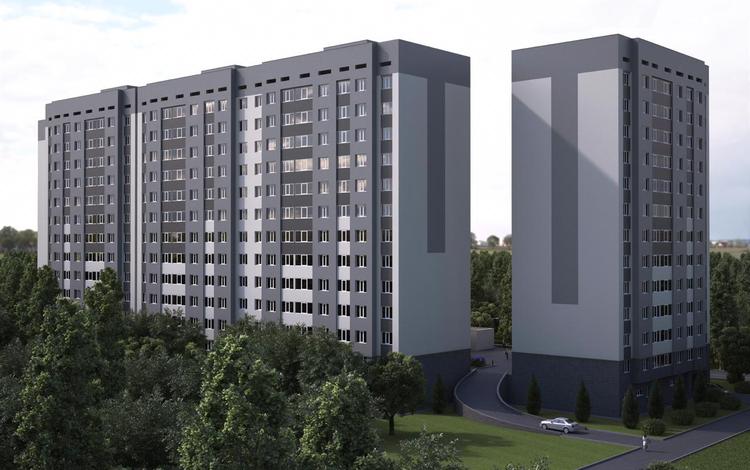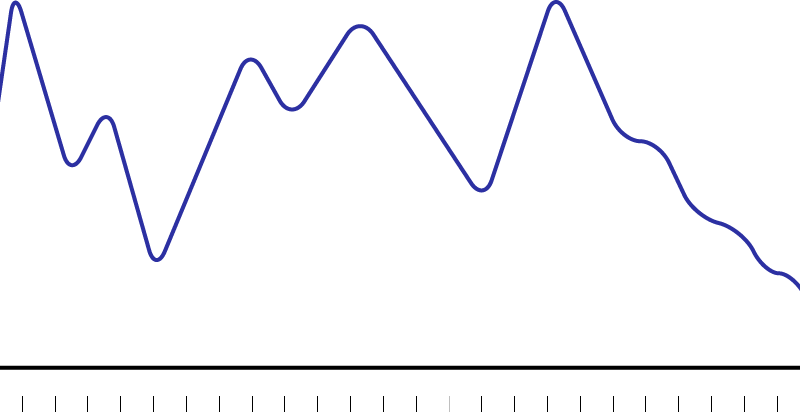Review of the regulatory framework
Overview of the regulatory framework
![Note: GOST R 53315, to which SP 6.13130.2013 refers, was canceled by Order of the head of Rosstandart dated November 22, 2012 No. 1097-st “On the Enactment of the Interstate Standard”. On January 1, 2014, GOST 31565-2012 Cable products. Fire safety requirements was put into effect for voluntary use in the Russian Federation as the national standard of the Russian Federation. [White light]](https://iowasmartidea.com/wp-content/uploads/2022/05/trening.jpg)
Technological development of the lighting engineering market in Russia leads to increased requirements on the part of customers to the supplied products – to the characteristics of the equipment, its quality, terms of development and delivery, availability of certificates. And this applies to emergency lighting almost in the first place, because this type of lighting is necessary for any object, regardless of its purpose and size. Requirements for emergency lighting are much more serious than for working lighting and are regulated by a number of regulatory documents.
Bely Svet experts have prepared a unique analytical review of the regulatory documentation in force (including those that have come into force since 2015) on the territory of the Russian Federation regarding the design and operation of emergency lighting systems and systems for warning and managing evacuation of people in case of fire.
Table of contents
I. Basic regulatory documents in the field of emergency lighting.
II. Terms and Definitions.
III. Requirements for emergency lighting systems.
IV. Requirements for emergency lighting control.
V. Requirements for equipment of emergency lighting systems.
V.1. Requirements for emergency lighting fixtures.
V.2. Requirements for light indicators.
V.3. Requirements for light fire alarms.
V.4. Requirements for central battery installations.
V.5. Requirements for electrical circuits and wiring of emergency lighting systems and SOUE.
I. Basic regulatory documents in the field of emergency lighting
The design and operation of emergency lighting systems and SOUE are regulated by a number of regulatory documents of the Russian Federation, which include Federal Laws, GOSTs and Codes of Rules.
The list of main regulatory documents (in force and coming into force in 2015) is presented below.
- Federal Law of the Russian Federation dated July 22, 2008 No. 123-FZ Technical Regulations on Fire Safety Requirements.
- Federal Law of the Russian Federation of December 30, 2009 No. 384-FZ Technical Regulations on the Safety of Buildings and Structures.
- SP52.13330.2011 (SNiP 23-05-95*, updated edition) Code of Rules Natural and artificial lighting. The requirements of SP 52.13330.2011 for emergency lighting (clauses 7.104-7.121) are included in the list of national standards and sets of rules, as a result of which, on a mandatory basis, compliance with the requirements of Federal Law No. 384-FZ Technical Regulations on the Safety of Buildings and Structures (Resolution Government of the Russian Federation No. 1521).
- GOST R 55842-2013 (ISO 30061:2007) Emergency lighting. Classification and norms. Date of introduction – 01.01.2015.
- GOST IEC 60598-2-22-2012 “Lights. Private requirements.Lamps for emergency lighting. (Introduced into force on 01.01.2015 instead of “GOST R IEC 60598-2-22-99“ Lamps. Part 2-22. Private requirements. Lamps for emergency lighting. ”)
- GOST R 12.4.026-2001 Signal colors, safety signs and signal marking.
- SP 1.13130.2009 Code of rules Fire protection systems. Evacuation routes and exits
- SP 3.13130.2009 Code of Rules Fire Protection Systems. The system of notification and control of the evacuation of people in fires. Fire safety requirements.
- SP 5.13130.2009 Code of rules Fire protection systems. Fire alarm and fire extinguishing installations are automatic. Norms and design rules.
- SP 6.13130.2013 “Fire protection systems. Electrical equipment. Fire safety requirements.
- GOST R 53325-2012 “Fire technique. Fire automation technical means. General technical requirements and test methods.
- Rules for the device of electrical installations (7th edition).
- GOST P50571.29-2009 (IEC 60364-5-55: 2008) “Electric installations of buildings. Part 5-55. Choosing and installing electrical equipment. Other equipment.
- GOST R 50571-5-56-2013 “Low-voltage electrical installations. Part 5-56. Choosing and installing electrical equipment. Security systems. Date of introduction – 01/01/2015.
- Fire regime rules in the Russian Federation.
- SP 113.13330.2012 Car parking (updated edition of SNiP21-02-99*).
The materials (images and text) presented in this section are intellectual property of the White Light 2000 LLC. Any use of materials is allowed only with the written permission of their copyright holder – LLC “White Light 2000”.
Return to the table of contents
II. Terms and Definitions
The definitions given in accordance with regulatory documents are indicated by the document number according to the list from section I in square brackets; The definitions that are absent in regulatory documents are prepared by experts of the White Light 2000 company and are denoted [white light].
A. Basic concepts.
1. Emergency lighting.
In the Code of Rules SP52.13330.2011, GOST IEC 60598-2-22-2012 and GOST R 55842-2013 identical definitions of the term “emergency lighting”. In GOST R 55842, it is discovered slightly wider and authenticly international definition.
Emergency lighting – lighting intended for use in violation of the nutrition of working lighting. [4]
At the same time, Russian federal laws No. 123-ФЗ and No. 384-ФЗ determine emergency lighting (AO) as a means of ensuring security in the event of a fire and other emergency situations.
Federal Law No. 123 considers the inclusion of emergency light as one of the ways to notify people and ensure their safe evacuation in a fire. In Federal Law No. 384 (Article 2, Part 2.1), an expanded determination of emergency lighting is given, in which 2 basic requirements for AO can be distinguished:
- the presence of an autonomous source of power supply that operates in a fire, accident and other emergency situations;
- The possibility of turning on emergency lighting when the alarm is triggered or manually.
In addition, in GOST R 55842-2013 (paragraph 4.2.1) it is said that “evacuation lighting should ensure the safe exit of people from the premises in the event of an emergency, for example, the refusal of working lighting, fire, etc.”
Thus, during the total consideration of the regulatory framework of the Russian Federation in relation to emergency lighting, one can come to the conclusion about the need to formulate a new definition that meets all relevant requirements.
As one of the possible options, “White Light” proposes to consider the following definition:
Emergency lighting – lighting feeds from an independent power source, which is automatically included in the event of a violation of the working lighting, when the appropriate alarm is triggered or manually. [White light]
2. Ways of evacuation – Ways for the evacuation of people in an emergency. [4]
3. The evacuation exit – Exit intended for use in an emergency. [4]
4. Evacuation lighting – type of emergency lighting for the evacuation of people or completing a potentially dangerous process. [4]
5. Reserve lighting – type of emergency lighting to continue work in case of disconnecting working lighting. [4]
6. Lighting of evacuation routes – type of evacuation lighting for reliable identification and safe use of evacuation routes. [4]
7. Antipanic lighting (evacuation lighting of large areas) – a type of evacuation lighting to prevent panic and a safe approach to evacuation routes. [4]
8. Evacuation lighting of increased danger zones – a type of evacuation lighting for the safe completion of a potentially dangerous work process. [4]
Note: In SP52.13330.2011 the term is used Evacuation lighting of increased danger, in GOST R 55842-2013- Lighting zones of increased danger.
9. Emergency lighting system – a set of technical means that jointly provide all types and modes of emergency lighting within the fire zone, room, building or structure. [White light]
10. Autonomous emergency lighting system (ASAO) – emergency lighting system, the elements of which are provided by power from individual autonomous power sources (emergency power supplies). [White light]
11. Centralized emergency lighting system (TsSAO) -emergency lighting system, the elements of which are provided by power from the general centralized power source (central battery installations; diesel-generator installations (DSU); sources of uninterrupted power (UPS); separate input of the power supply system, which are beyond the main input). [White light].
12. Group of emergency lighting (GSAO) – emergency lighting system, the elements of which are provided by power supply from a power source located in the same fire zone (group batteries, UPS). [White light]
Classification of emergency lighting according to SP52.13330.2011.
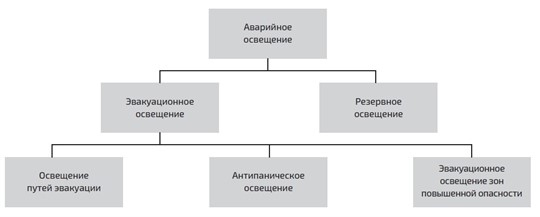
B. Equipment of emergency lighting systems and SOUE.
13. Emergency lamp – A light device designed to work in emergency lighting systems in order to ensure normalized illumination and illumination of safety signs. [White light]
14. Safety sign – a sign that gives information about security measures (prohibition, prescription or resolution of certain actions) using a combination of color, shape and graphic symbols or text. [4]
15. Light pointer / safety sign with internal backlighting – Safety sign, illuminated from the inside. [4]
16. Fireman Elealor – A technical tool designed to notify people about the fire through the supply of light, sound or speech signal. [11]
17. The distance of recognition – distance from the observer to the safety sign, on which this sign is considered distinguishable. [White light]
The recognition distance is calculated by the formula:
l = h * z,
L. – recognition distance, m;
h – height of the safety sign, m;
Z – distance factor (coefficient equal to 200 for safety signs with internal backlight).

Note: SP52.13330.2011 uses the term Lencing distance, in GOST R 55842-2013- Distinction distance.
18. Independent source of PutiniI am a power source on which the voltage in post – – – – -the -the -air mode remains within the regulated limits when it disappears by the insistence or other power sources. [12]
19. Emergency lamp of constant action – a lamp, in which lampiastal lighting is constantly working – in normal and emergency mode (when working or emergency lighting is necessary). [5]
Note: The term “lamps” in this context should be understood as a broader concept – “light sources” (including LEDs). [White light]
20. Emergency lamp of inconsistent action – a lamp in which emergency lighting lamps only work in emergency mode. [5]
21. Combined emergency lamp – a lamp with two or more sources of light, at least one of which works from the emergency lighting network, while the others from the power lighting network. A combined lamp can be constant or inconsistent. [5]
22. Emergency power supply – a device that ensures the operation of emergency light lighting sources in emergency mode, as well as the battery charge, network voltage control, indication, control of control signals and switching between operating modes. [White light]
23. Autonomous emergency lamp – a lamp in which all the elements providing its work in emergency mode (batteries, light sources, emergency power supply, etc.) are located in the lamp or next to it (within the length of the cable 1 m). [5]
24. Normal mode – The condition of the autonomous lamp capable of working in emergency mode when the network of food lighting is enabled. In case of damage to the power lighting network, the autonomous lamp automatically switches to emergency mode. [5]
25. Emergency mode – the condition of the autonomous lamp, which provides for lighting, provided from an internal power source, with violations of the power lighting network. [5]
Note: The concepts of normal and emergency regime can also be attributed to the emergency lighting system as a whole. [White light]
26. Waiting mode – the condition of the autonomous lamp, in which it is deliberately in the off state, while the power supply is turned off, and which, in case of resuming the power of the working lighting, is automatically returned to the operating mode. [5]
27. Remote delay mode – the condition of the autonomous lamp, in which its work is delayed using a remote device when the operating power is turned on, and when it is disconnected, switching into emergency mode does not occur. [5]
28. Composite autonomous emergency lamp – lamp, equipped with an emergency power source for the auxiliary lamp. [5]
29. Auxiliary emergency lamp – lamp, whose emergency power supply is placed in an emergency lamp associated with it. [5]
30. Emergency lamp of centralized power supply – a lamp of a constant or inconsistent action, the nutrition of which is carried out from a centralized emergency system. [5]
Note: Emergency lamps of centralized power supply are part of both centralized and group emergency lighting systems.
As an independent power source in centralized emergency lighting systems, central rechargeable units (CAUs), generator and power plants, separate inputs of the power supply system, etc. are used.
In group lighting systems as an independent power source, group batteries and emergency power supplies are used, designed for the power of several lamps.
31. Controlled emergency lamp of centralized power supply – a lamp connected to a constant central battery of a constant action (uninterrupted power source) with the ability to control it together with the lighting installation of working lighting. [White light]
32. Central battery installation -a source of power supply with a standard output voltage, usually designed to power several consumers and consisting of at least one battery, automatic charging, control and testing devices.
Note: The battery installation may have a combined AC and DC output and include additional electrical and electronic devices: contactors, switches, isolating transformers, converters, etc. [13]
33. Group battery installation – a power supply source with a standard output voltage, designed to power several consumers within the same fire zone and consisting of at least one battery, automatic charger, test and distribution devices. [White light]
The materials presented in this section (images and text) are the intellectual property of Bely Svet 2000 LLC. Any use of materials is allowed only with the written permission of their copyright holder – Bely Svet 2000 LLC.
Back to index
III. Requirements for emergency lighting systems
Below are the main requirements for emergency lighting systems in accordance with the Code of Rules SP52.13330.2011, unless otherwise indicated.
Emergency lighting is divided into two main types: evacuation lighting and backup lighting.
In turn, evacuation lighting includes:
- illumination of evacuation routes;
- anti-panic lighting (evacuation lighting of large areas);
- evacuation lighting of high-risk areas.
Lighting requirements for various types of emergency lighting are given in the table:
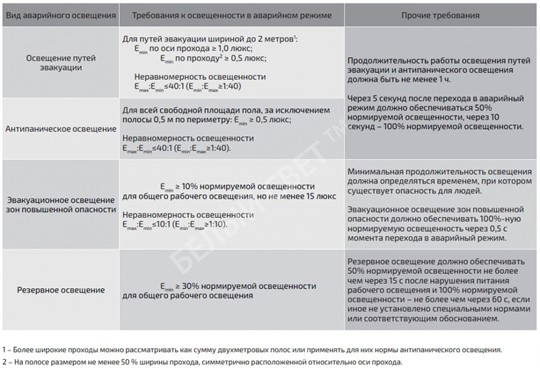
GOST R 55842-2013 clarifies lighting requirements for some evacuation lighting facilities:

emergency lighting must provide acceptable visual conditions for the evacuation of people in the event of an accident, fire or other emergency.
Escape route lighting in premises or in places where work is performed outside buildings, the following should be provided:
- at the intersection of aisles and corridors;
- before each emergency exit;
- in front of each point of medical care;
- in places where emergency communications and other means intended for notification of an emergency are located.
Anti-panic lighting aimed at preventing panic and providing conditions for a safe approach to escape routes. It is provided in large rooms – with an area of more than 60 m 2.
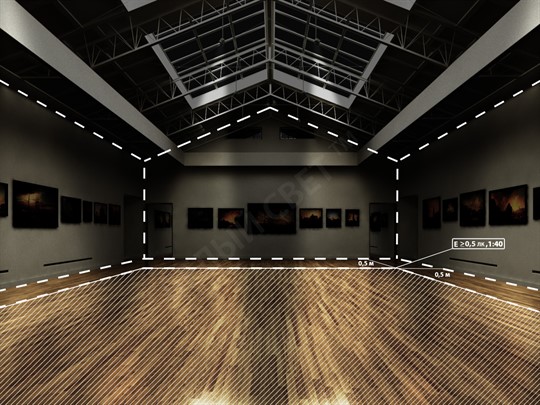
Evacuation lighting for high-risk areas should be provided for the safe termination of a potentially dangerous process or situation.
Backup lighting should be provided if, according to the conditions of the technological process or situation, normal continuation of work is required in the event of a power failure of the working lighting, and also if the associated disruption in the maintenance of equipment and mechanisms can cause:
- death, injury or poisoning of people;
- explosion, fire, long-term disruption of the technological process;
- leakage of toxic and radioactive substances in the environment;
- Violation of the operation of such objects as electric stations, radio and television gears and communications, dispatching points, pumping water supply, sewage and heatification installations, installation of ventilation and air conditioning for industrial premises in which the termination of work is unacceptable, etc.
Light signs (safety signs with internal backlight) are installed:
- over each evacuation exit;
- on the ways of evacuation, unambiguously indicating the directions of evacuation;
- to indicate a post of medical care;
- to indicate the places of placement of primary fire extinguishing means;
- To denote places of placement of emergency communications and other funds intended to notify the emergency.
The requirements for the installation of light signs and light fire warrior (in the warning and management systems of evacuation) are given in the table:
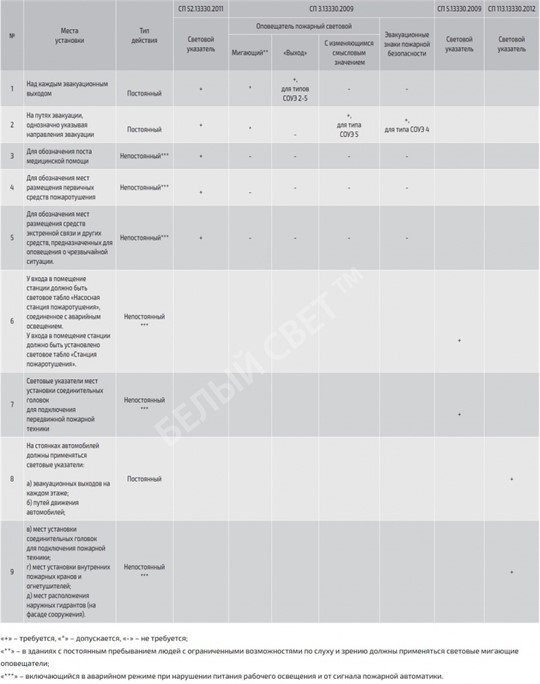

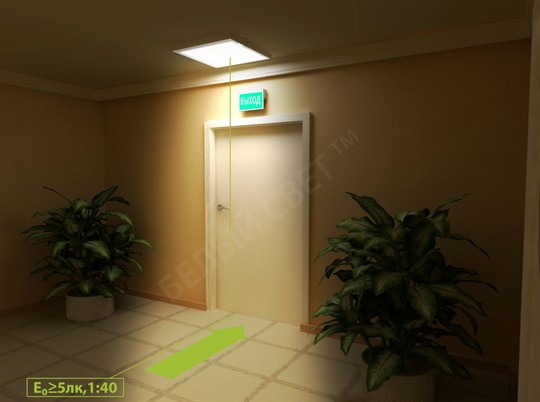
The distance between the two neighboring light signs along the evacuation path should not exceed the value of the recognition of the signs used. At the same time, according to SP 3.13130.2009 (paragraph 5.4), in corridors more than 50 meters in a length of more than 50 meters, this distance should not exceed 25 meters.
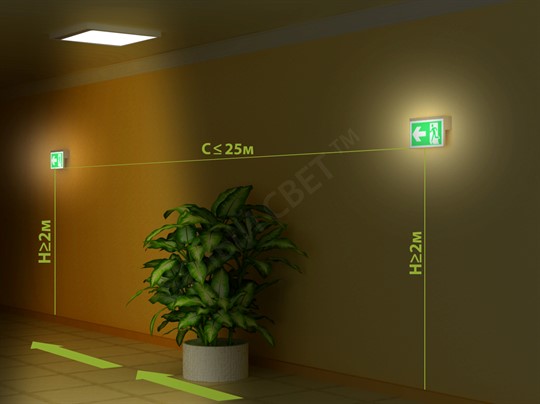

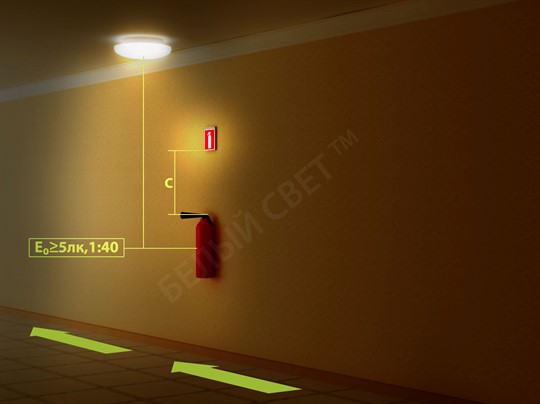
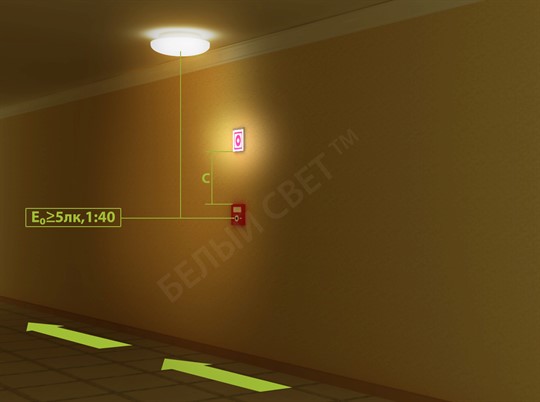
Food of light signs in normal mode should be made from the source, regardless of the power of the working lighting; In emergency mode, switch to food from the third independent source, for example, a battery built into the lamp.
The duration of the light signs should be at least 1 hour and correspond to the estimated evacuation time.
Note: For buildings with the stay of low -mobility groups of the population, high -rise buildings and hotels, the duration of emergency lighting and light signs from 3 to 8 hours may be required. [14, Appendix A]
Also in paragraph 6.4.5 of the Code of Rules SP 113.13330.2012 “Car parking” states:
The ways of driving inside the parking lots should be equipped with indicators orienting the driver.
Lamps indicating the direction of movement are installed in turns, in places of changes in slopes, on ramps, entrances to the floors, entrances and exits on the floors and stairwells.
The indicators of the direction of movement are installed at a height of 2 and 0.5 m from the floor within the line of sight from any point on the ways of evacuation and driveways for cars.
Light signs of the installation sites of connecting heads for fire equipment, installation sites of fire cranes and fire extinguishers should be automatically turned on when fire automation systems are triggered. [16]
The materials (images and text) presented in this section are intellectual property of the White Light 2000 LLC. Any use of materials is allowed only with the written permission of their copyright holder – LLC “White Light 2000”.
Return to the table of contents
IV.Requirements for emergency lighting management
In GOST R 50571.5.56-2013, the requirements for emergency lighting management are spelled out.
According to paragraph 560.9.5 of this document:
- In inconsistent mode, power supply for conventional lighting should be controlled in the final circuit for this zone. If the loss of nutrition leads to the cessation of ordinary lighting in this area, emergency lighting should be turned on automatically. Corresponding measures must be provided to guarantee that emergency lighting will work in the case of power loss in the corresponding local zone. [fourteen]
The implementation scheme of this requirement in practice depends on the emergency lighting system and the functionality of the equipment used, however, the BS-RKF module (phase control relay) will be a common element of such circuits:
1) Control circuit of emergency lighting in the autonomous emergency lighting system:
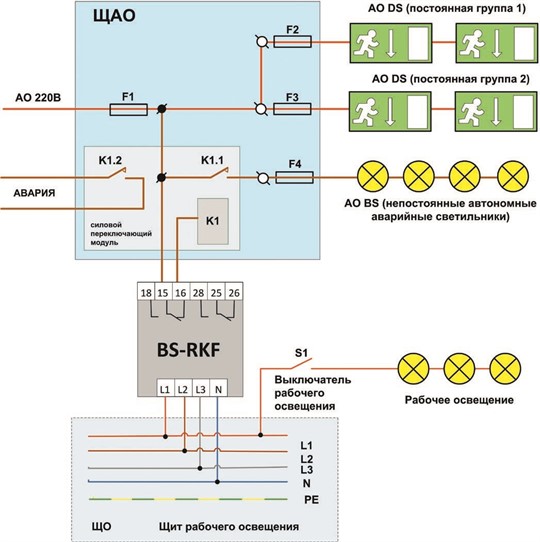
2) the control scheme of emergency lighting in the centralized emergency lighting system:
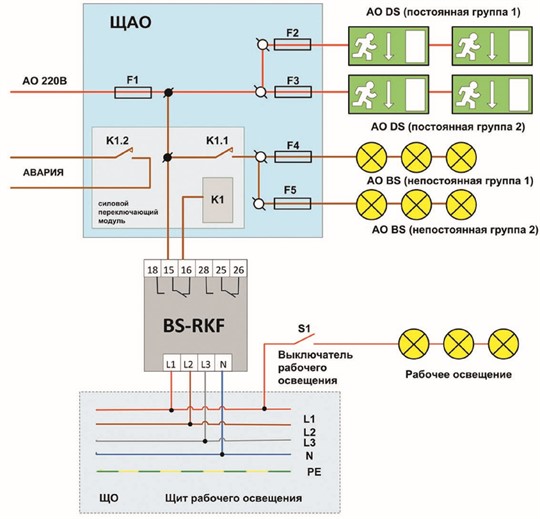
- Control systems and local security lighting networks should be independent of control and local networks for general lighting; The connection of both systems can only be carried out by devices that guarantee the separation/insulation of both tires from each other. The refusal of control systems and local lighting networks should not affect the performance of security lighting functions. [fourteen]
- If normal power is restored in the distribution cabinet or in the power circuit, then emergency lighting in a sharing mode should automatically turn off. The time required to set normal brightness with ordinary lighting lamps should be taken into account. In the premises that were deliberately darkened before the power was lost, emergency lighting should not turn off automatically. [14]
For the fulfillment of the last requirement:
- In the autonomous emergency lighting system, the time delay relay should be provided in the emergency lighting shields (SCHAO) in unstable groups of emergency lamps or autonomous emergency lighting lamps with the function of switching to the operating mode from emergency;
- The source of independent nutrition of the centralized and group of emergency lighting should have the function of delaying the time of turning off the emergency regime of unstable groups after restoration of the working lighting (implemented in the BS-ELECTRO CAU);
- For premises that were pre-darkened (theaters, circuses, cinemas, etc. During the presentation), emergency control panels (BS-Puao) should be used for manual turning off the emergency mode.
In addition, according to the rules of the fire regime in the Russian Federation (paragraph 349), the equipment of warehouses should be de -energized at the end of the working day.In this regard, for the normal operation of the autonomous emergency lighting system in warehouses, it is necessary to use the remote control and control device (TeleControl), which allows you to transfer emergency lamps from the emergency mode into a remote delay mode after de -energizing the warehouse equipment.
The materials (images and text) presented in this section are intellectual property of the White Light 2000 LLC. Any use of materials is allowed only with the written permission of their copyright holder – LLC “White Light 2000”.
Return to the table of contents
V. Requirements for the equipment of emergency lighting systems
In addition to the requirements directly to the emergency lighting system, there are a number of specific requirements for the elements of this system: emergency lighting lamps, light signs, safety signs, battery installations.
V.1. Requirements for emergency light lamps.
The basic requirements for emergency lighting lamps are formulated in federal laws No. 123-ФЗ and No. 384-ФЗ, GOSTIEC 60598-2-22-2012, SP52.13330.2011 (SNiP 23-05-95*):
1. The possibility of checking performance.
The Federal Law of the Russian Federation dated 07.22.2008 No. 123-ФЗ (Article 82, part 9) indicates a mandatory requirement for autonomous emergency lighting lamps:
- Emergency lighting lamps on the tracks of evacuation with autonomous power sources should be provided with devices to check their performance when simulating the shutdown of the main power source. [1]
At the same time, according to GOST IEC 60598-2-22-2012 (paragraph 22.20), the test device must model the refusal of the working network of power, without affecting the normal operation of the lamp.
Verification of performance can be carried out both using individual “test” buttons included in the design of the lamps, and when using remontrol devices (Telecontrol). In both cases, the requirements of the lack of influence on the normal operation of autonomous lamps (including the charge of the battery) are observed.
2. The possibility of turning on from the signal of the automatic fire alarm.
In a number of regulatory documents, including federal laws No. 123-ФЗ, No. 384-ФЗ, SP5.13130.2009 and SP113.13330.2012, emergency lighting system is considered in conjunction with the APS system.
Thus, depending on the emergency lighting system, various solutions should be applied at the facility:
- For the ASAO – electronics of autonomous emergency lighting lamps should be able to connect to the fire automation system, upon receipt of the corresponding signal from which the lamps operating in unstable mode should turn on (go into emergency mode of operation).
- For the CSAO and GSAO – the design solution should be laid down the possibility of turning on unstable groups of lamps from the fire automation signal.
3.Design requirements.
Requirements for the design of the emergency lamp case, circuitry solutions of emergency power supplies, electrical insulation, etc. They are fully described in paragraphs 22.6-22.20 GOST IEC60598-2-22-2012.
Separately, a distinctive feature of emergency lamps from the lamps of working lighting can be noted – the tests of the body for heat resistance are carried out at a temperature of 850 ° C.
4. Requirements for light sources.
Code of Rules SP52.13330.2011 (SNiP 23-05-95*) allows the following types of light sources as emergency:
- LED light sources;
- Luminescent lamps – in rooms with a minimum air temperature of at least 5 ° C and provided that the lamps are powered in all modes with a voltage of at least 90% nominal;
- high -pressure discharge lamps, provided that their instant or quick re -ignition is hot after a short shutdown and in a cold state;
- incandescent lamps – if it is impossible to use other light sources.
The requirement for all types of evacuation lighting: the total color rendering index of the used light sources should be at least 40.
V.2. Requirements for light signs
Light signs (as one of the types of emergency lamp) include all the requirements listed in section IV.1, and a number of private requirements.
All requirements of GOST R 12.4.026-2001 “Signal colors, safety signs and signal marking”, i.e.
- The background of the evacuation sign of safety should be green, graphic symbols and explanatory inscriptions – white; The main colors of the fire safety sign are red and white.
- Along the perimeter of the sign should be applied with white kant in color with a width of at least 0.025 of the height of the sign.
- The ratios of the parties to fire safety signs, evacuation safety signs and safety signs of medical and sanitary purposes, taking into account the White Kant, should be strictly: 2: 1 – for rectangular safety signs, 1: 1 – for square safety signs.
According to SP52.13330.2011 (SNiP 23-05-95*), the brightness of the light pointer in emergency mode at any place of the safety zone of the corresponding sign should not be lower than 10 kD/m 2 or 2 kD/m 2, if smoke (in fire) It is not considered as a danger factor.
In GOST R 55842-2013, the requirements for the uniformity of the brightness of the safety signs of light signs were uniformly distributed:
- The uniformity of the distribution of brightness within the color surface of the safety sign is determined by the ratio of the minimum brightness to maximum within the surface of the sign, which should be at least 1: 5.
- For a safety sign with a brightness of more than 100 KD/m2, the ratio of the minimum brightness value to the maximum within the color surface of the sign should be at least 1:10.
- The ratio of the brightness of the contrasting color to the brightness of the color color should be at least 5: 1 and no more than 15: 1.
The recognition distance for light indicators depends on the height of the sign and is determined by the formula specified in section II, clause 16.
V.3. Requirements for light fire alarms
Requirements for light fire alarms are described in SP 3.13130.2009 Code of Rules “Fire protection systems. Warning system and management of evacuation of people in case of fires. Fire safety requirements” and GOST R 53325-2012 “Fire fighting equipment. Technical means of fire automatics. General technical requirements and test methods.
- Fire alarms interacting with the control device for technical means of warning and evacuation control, or other devices, must ensure informational and electrical compatibility with them (GOST R 53325-2012, clause 6.2.1.2).
- Dimensions and signal colors of light fire alarms must comply with the requirements of GOST R 12.4.026-2001 this information when the illumination of annunciators is in the range of values specified in the TD for annunciators of specific types, but not less than from 1 to 500 lx*. A flashing light fire alarm should have a flashing frequency in the range from 0.5 to 2.0 Hz. The flashing frequency must be specified in the TD for light fire alarms of specific types. The dimensions and content of the inscriptions on light fire alarms are set in the TD for fire alarms of specific types (GOST R 53325-2012, clause 6.2.1.7).
Note: probably, GOST R 53325-2012 incorrectly indicates the lighting value (“illuminance” instead of “brightness”) and, accordingly, the dimension of this value (“lux” instead of “candles per square meter”), a more correct wording: “… at brightness ( …) from 1 to 500 cd/m2.” [White light]
V.4. Requirements for battery installations
Requirements for battery installations can be divided into 2 groups: electrical and fire.
1. Electrical requirements for battery installations are described in detail in two regulatory documents:
- GOST R 50571.29-2009 (IEC 60364-5-55:2008) “Electrical installations of buildings. Part 5-55. Selection and installation of electrical equipment. Other equipment.
Basic requirements for battery installations:
- use only automatic chargers, the technical characteristics of which must comply with the data of the manufacturers of the batteries used;
- after the restoration of normal power supply, the unit should automatically turn on in the operating mode and start charging the battery;
- chargers should be capable, immediately after the restoration of normal power supply, to automatically charge a discharged battery within 12 hours to a level where it can provide at least 80% of the estimated duration of operation of this source;
- The installation should be equipped with an automatic device for protecting the battery from a deep discharge with a level of operation, installed by the manufacturer of the battery of the type used;
- The charger must provide automatic compensation for the charging voltage depending on the temperature of the battery, if it is provided for by the manufacturer of the batteries;
- Closed batteries should be used for lead-acid (VRLA) and valve type for nickel-cadmium;
- The service life of batteries at a temperature of 20 ° C should be at least 10 years;
- Control and test devices should provide functions according to the table (Appendix A GOST R 50571.29-2009):
2. Fire requirements for battery installations are relevant when considering them as a device that combines the source of uninterrupted power supply of fire automation equipment (firefighters) and fire control (PPU). These requirements are described in GOST R 53325-2012 “Fire technique. Fire automation technical means. General technical requirements and test methods:
- Powering the source of uninterrupted power supply of fire automation equipment (hereinafter referred to as IE) should be carried out from at least two independent sources of power supply (main and backup).
- IE must provide uninterrupted power supply of fire automation equipment when disappeared or voltage reduced for any power supply.
- The value of the output voltage of the IE during power from the main source of power supply in the range of permissible current values in the output circuit should be in the range from 90% to 110% of the nominal value.
- When used as a backup source of power supply to the batteries, IE should provide:
- battery charge during power from the main source of power supply;
- automatic formation of a malfunction signal with a minimum voltage of the battery indicated in the TD on IE;
- Preservation of working capacity during a break in or short circuit of the battery circuit.
- IE must provide indication:
- the presence (within the norm) of the main and backup power (separately for each input of power supply);
- the presence of output voltage.
- IE should ensure the formation and transmission of information to the external circuits about the absence of output voltage, the input voltage of the power supply to any entrance, the discharge of batteries (if any) and other malfunctions controlled by the IE. The formation of a generalized malfunction signal is allowed.
- IE must have automatic protection against a short circuit at the output and increasing the output current above the maximum value specified in the TD on IE.
- IE must maintain its parameters when voltage changes in any input of power supply from 80% to 115% of the nominal value.
- The installation should be equipped with an automatic device for protecting the battery from a deep discharge with a level of operation, installed by the manufacturer of the battery of the type used;
- The charger must provide automatic compensation for the charging voltage depending on the temperature of the battery, if it is provided for by the manufacturer of the batteries;
- Closed batteries should be used for lead-acid (VRLA) and valve type for nickel-cadmium;
The service life of batteries at a temperature of 20 ° C should be at least 10 years;
Control and test devices should provide functions according to the table (Appendix A GOST R 50571.29-2009):
- 2. Fire requirements for battery installations are relevant when considering them as a device that combines the source of uninterrupted power supply of fire automation equipment (firefighters) and fire control (PPU). These requirements are described in GOST R 53325-2012 “Fire technique. Fire automation technical means. General technical requirements and test methods:
- Powering the source of uninterrupted power supply of fire automation equipment (hereinafter referred to as IE) should be carried out from at least two independent sources of power supply (main and backup).
- IE must provide uninterrupted power supply of fire automation equipment when disappeared or voltage reduced for any power supply.
The value of the output voltage of the IE during power from the main source of power supply in the range of permissible current values in the output circuit should be in the range from 90% to 110% of the nominal value.
- When used as a backup source of power supply to the batteries, IE should provide:
battery charge during power from the main source of power supply;
- automatic formation of a malfunction signal with a minimum voltage of the battery indicated in the TD on IE;
- Preservation of working capacity during a break in or short circuit of the battery circuit.
- IE must provide indication:
- the presence (within the norm) of the main and backup power (separately for each input of power supply);
- the presence of output voltage.
- IE should ensure the formation and transmission of information to the external circuits about the absence of output voltage, the input voltage of the power supply to any entrance, the discharge of batteries (if any) and other malfunctions controlled by the IE. The formation of a generalized malfunction signal is allowed.
IE must have automatic protection against a short circuit at the output and increasing the output current above the maximum value specified in the TD on IE.
IE must maintain its parameters when voltage changes in any input of power supply from 80% to 115% of the nominal value.
- IE governing bodies should be protected from unauthorized access.
- The degree of protection of IE should be at least IP30 in accordance with GOST 14254.
- Devices that contain the registration and storage of data on events should provide registration of all events and have a volume that allows you to save at least 1024 reports about events.
- V.5. Requirements for electric circuits and electrical wiring of emergency lighting systems and SOUE
- The complex of requirements for electric circuits and electrical wiring of emergency lighting systems and SOUE is described in the following documents:
- Federal Law of the Russian Federation dated 07.22.2008 No. 123-ФЗ “Technical Regulation on Fire Safety requirements”.
- SP 6.13130.2013 “Fire protection systems. Electrical equipment. Fire safety requirements.
GOST R 50571-5-56-2013 “Low-voltage electrical installations. Part 5-56. Choosing and installing electrical equipment. Security systems.
In SP 6, the requirements for the types of cables used and the conditions for their laying are specified:
Cables and wires of the SPZ (fire protection systems), laid down singlely (the distance between cables or wires of more than 300 mm) must have an indicator of a fire hazard not lower than PRGP 4 according to GOST R 53315.
Cables and wires of the SPZ laid during a group laying (the distance between cables is less than 300 mm) must have a fire hazard indicators for non -proliferation of burning PRGP 1, PRGP 2, PRGP 3 or PRGP 4 (depending on the volume of the combustible load) and a smoke formation indicator not lower than PD 2 according to GOST R 53315.
Cable lines and wiring of the SPZ,laid monolithically, in the voids of building structures made of non-combustible materials or in metal pipes with a localization ability, it is allowed to carry out cables or wires that do not have requirements for non-propagation of combustion, while the ends of the channels and pipes included in electrical equipment and junction boxes must be hermetically sealed with non-combustible materials.
Electrical cable lines and electrical wiring of the SDR must be carried out with cables and wires with copper conductors.
(495) 785-17-67
Cable lines and electrical wiring of fire protection systems, means of ensuring the activity of fire departments, fire detection systems, warning and control of people evacuation in case of fire, emergency lighting on evacuation routes, emergency ventilation and smoke protection, automatic fire extinguishing, internal fire water supply, elevators for transporting units fire protection in buildings and structures must remain operational in a fire for the time necessary to perform their functions and complete evacuation of people to a safe area.
The operability of cable lines and electrical wiring of the SPZ in fire conditions is ensured by the choice of the type of cable and wire execution, in accordance with GOST R 53315, and the method of their laying. The service life of cable lines and electrical wiring under fire conditions is determined in accordance with GOST R 53316.

